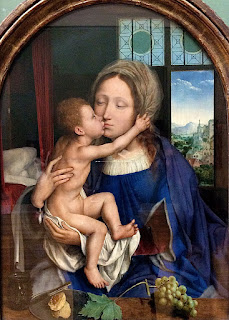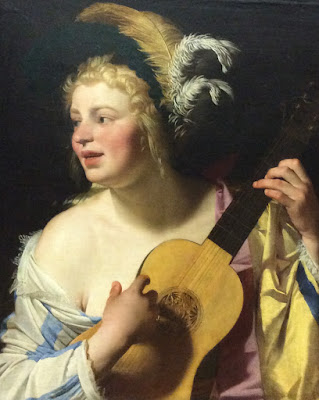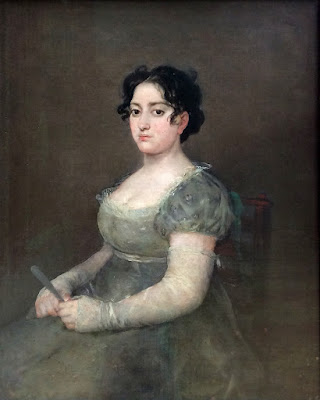The Louvre has many masterpieces of Dutch and Flemish art, but photographic conditions are very difficult in those galleries. Glazing and glare are the foremost problems: many works are covered by glass, and many galleries have improperly shielded skylights that make streaky reflections on the glass. Many small but important works from the early era of art history are shown in small dark rooms where it is hard to see the paintings, let alone photograph them. Many large paintings are hung well above eye-level. The little camera on my iPad was quite overwhelmed.
Early Netherlandish Art
Early Netherlandish painting coincides with the Early and High Italian Renaissance but is seen as an independent artistic culture, separate from the Renaissance humanism that characterised developments in Italy.
The northern painters' doctrine was built more on elements of recent Gothic tradition and less on the classical tradition prevalent in Italy.
Early Netherlandish paintings reveal the pursuit of a common goal—to make the painted image vividly present and to render the unseen palpable.
1400s—The Renaissance Period
In the early 1400s—the time of Fra Angelico and Andrea Mantegna in Italy—the Lowlands had Jan van Eyck and Rogier van der Weyden.
 |
| Jan van Eyck, c. 1390-1441 The Virgin of Chancellor Rolin, c. 1435 Photo by Dan L. Smith |
 |
| Rogier van der Weyden, 1399-1464 Braque Family Triptych, 1450 |
 |
| Hans Memling, c. 1435-1494 Virgin and Child with Sts James and Dominic, c. 1490 |
 |
| Quentin Metsys, 1466-1530 The Virgin and Child, 1529 |
 |
| Joos van Cleve, c. 1485-c. 1541 Salvator Mundi, Savior of the World, 1500-1520 |
1500s—Mannerist period
During the Mannerist period in Italy, the time of Bronzino, in the Lowlands there was Marinus van Reymerswaele and Jan Massys.
 |
| Marinus van Reymerswaele, c. 1490-1566 Two Tax Collectors, c. 1540 |
 |
| Jan Massys, c. 1509-c. 1575 David and Bathsheba, 1562 |
1600s—Baroque
During the Baroque period of Italian art—the time of Caravaggio and Guido Reni—art of the Lowlands reached its peak with Peter Paul Rubens, Frans Hals, Anthony van Dyck, Rembrandt, and Vermeer.
Peter Paul Rubens
This sort of dramatic and fleshy work is typical for Rubens.
 |
| Peter Paul Rubens, 1577-1640 The Death of Didon, c. 1638 |
 |
| Peter Paul Rubens, 1577-1640 Countryside with Ruins of Palatine in Rome |
It was simply unprecedented to aggrandize a woman's life in this way. Rubens' painting style was sufficiently grandiose to meet the demands of even the most egoistic patron, replete with allegory and glorification. Both the concept and the execution are amazing. The canvases originally decorated the Luxembourg Palace, the Queen's residence. Now they have their own beautiful gallery at the Louvre.
The vertical canvases are about 13 feet tall while the horizontal canvases are about 37 feet wide.
 |
| The Consignment of the Regency |
 |
| The Victory at Jülich |
 |
| Louis XIII Comes of Age |
Anthony van Dyck spent much of his career in England, working for royalty.
 |
| Anthony van Dyck, 1599-1641 Portrait of Charles Louis I and his Brother Robert, 1637 |
Frans Hals
Wealthy sitters had to look their best, but with musicians and gypsies Hals could create spontaneous and relaxed portraits.
 |
| Frans Hals, 1580-1666 The Gypsy Girl, c.1628 |
 |
| Frans Hals, 1580-1666 Buffoon with a Lute, 1626 |
 |
| Pickenoy, 1590-1656 (attributed to) Portait of a Woman aged 34, 1634 |
 |
| Gerrit van Honthorst, 1590-1656 Woman Playing a Guitar, c. 1624 |
 |
| Salomon van Ruysdael, 1602-1670 Golden Seascape, 1665 |
Rembrandt painted over ninety portraits of himself—a record—and the Louvre has several of these. It is quite moving to see his frank report of his maturing personality and his aging appearance, but most of the paintings were obscured by glare. This one is special because it shows Rembrandt bare-headed; he usually wore handsome headgear.
 |
| Rembrandt, 1606-1669 Self-portrait with Bare Head, 1633 |
 |
| Rembrandt, 1606-1669 Bathsheba at Her Bath, 1654 |
Landscapes with cows and horses were popular in the 1600s. Two artists who specialized in these were Albrecht Cuyp and Paulus Potter.
 |
| Albrecht Cuyp, 1620-1691 Landscape near Rhenen, c. 1655 |
 |
| Paulus Potter, 1625-1654 The Spotted Horse, 1653 |
Johannes Vermeer liked to paint lovely young women involved in some task or some train of thought; the light is always clear and serene. This example is very small, and a crowd of tourists hovers around it constantly.
 |
| Johannes Vermeer, 1632-1675 The Lacemaker, c. 1670 |
While art in Italy peaked during the 1400s and 1500s, in the Lowlands the 1600s produced the greatest number of masters.
Art of Spain
The Louvre has only a small collection of Spanish art, and they treat it like an extension of Italian art. Italian art fills a block-long gallery plus a couple of rooms along the side; at the end of the long gallery, and down a few steps, is a medium-size gallery with a dozen Spanish works. Happily, this gallery has fairly bright and even light.
1500s
El Greco
During the Mannerist period—the time of Bronzino in Italy and Jan Massys in the Lowlands—the greatest artist working in Spain was El Greco. You can see the influence of Mannerism in his elongation of form and heightening of drama.
 |
| El Greco, 1541-1614 Christ on the Cross Adored by Donors, c. 1590 |
 |
| El Greco, 1541-1614 St. Louis, King of France, with a Page, c. 1590 |
1600s
Bartolomé Esteban Murillo
During the 1600s—the Baroque period in Italy and the Golden Age of Dutch art—one of the most important, and most versatile, artists in Spain was Bartolomé Esteban Murillo.
This sort of sweet and reverent painting is what he is best known for.
 |
| Bartolomé Esteban Murillo, 1618-1682 |
 |
| Bartolomé Esteban Murillo, 1618-1682 The Angels’ Kitchen, 1646 |
1700s
During the time of Panini in Italy, when major artists were no longer emerging in the Lowlands, an artist named Luis Meléndez was working in Spain. Although he was extremely talented, he is not usually considered among the big stars of Spanish art. Most of his work is still lifes, so I was delighted to see this excellent self-portrait from his student days.
 |
| Luis Meléndez, 1716-1780 Self-portrait Holding an Academic Study, 1746 |
1800s
Francisco de Goya
Painting was in a decline in Italy and the Lowlands in the 1800s, but Spain produced one of its greatest masters: Francisco de Goya. The museums of Madrid have managed to retain most of Goya's work. Here's is a minor example of his skill as a portrait artist.
 |
| Francisco de Goya, 1746-1828 Portrait of a Lady with a Fan, 1807 |
Conclusion of Spanish Art
This is only a tiny sample of the wealth of Spanish art, but it is enough to see that painting developed a little later in Spain than in Italy or the Lowlands, and it was still vital in the late 1700s and early 1800s.